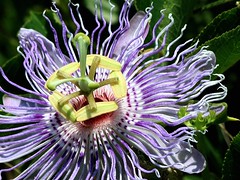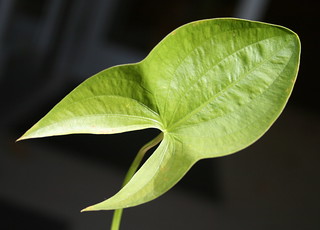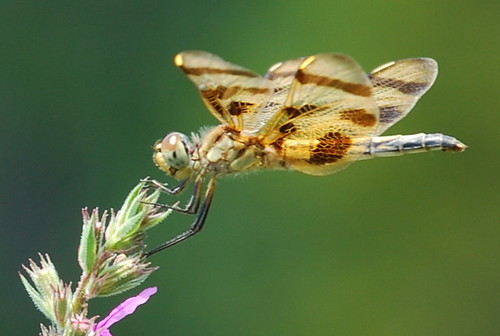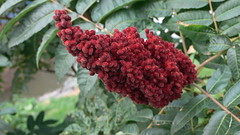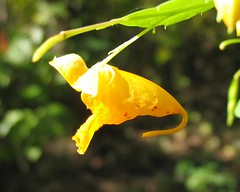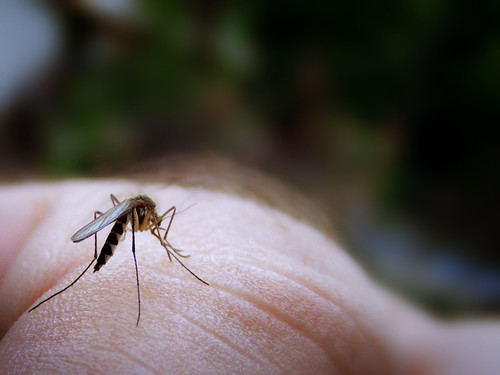Fall foliage will start becoming more apparent soon. See our list of favorite local places to enjoy the color, and leave a comment with your own favorite spot. Or try our quiz of 10 fall leaves.
Getting outside, inside the beltway: tips on getting outdoors in the Washington, DC area.
Most Popular Posts
-
Photo credit: ilkerender Last year we listed places to swim near DC and places to rent a canoe near DC . Today we return to complete the s...
-
Summer calls out for being on the water. We've found more than a dozen locations where you can rent a canoe or kayak in the Washington, ...
-
What a lovely break in the heat we're having. Here are some things to keep an eye out for in August. Links are to previous LOOK FOR post...
-
This spring has been cold and a little slow, like last year. Morels , in particular, are just starting to show up. Below are all the things ...
-
The Jack in the pulpits are starting to unfurl right now. I've always loved these flowers, showy in their design rather than their color...
-
I've been distracted from the Natural Capital but I haven't totally forgotten about you guys...Here are some of the other things we ...
-
This time last year, the wood frogs were out and had already laid their eggs. As of this morning, the pond where we always find them was com...
-
Our monthly roundup of things to look for this month: Photo credit: InspiredinDesMoines I originally wrote about bald eagles for t...
-
Two of the things we love best about living in the DC metro area are the public transportation system, and the parks. And so, one of our mai...
-
If I had to name my biggest frustration with the nature around DC, the lack of good swimming holes might top the list. Until 7th grade I liv...
Sunday, October 12, 2014
Things to look for in October
I've been distracted from the Natural Capital but I haven't totally forgotten about you guys...Here are some of the other things we try to take time to enjoy in October. What have you been noticing lately?
Fall foliage will start becoming more apparent soon. See our list of favorite local places to enjoy the color, and leave a comment with your own favorite spot. Or try our quiz of 10 fall leaves.
Wild Grapes are tart but tasty trailside treats -- if you can reach them. Have you found any lately?
Acorns have been dropping. We've been playing around with making acorn flour: take off the shells, grind the nutmeats into coarse flour, then put them in a filter and let them soak in repeated changes of water over several days. Then dry and grind into finer flour. Use it to replace a little flour in any baking recipe that doesn't require a lot of gluten. We love it in pancakes.
Virginia Creeper has started to turn a brilliant red. It's the harbinger of fall color.
New England Asters are lighting up our backyard right now, and on a sunny day they're covered in pollinators. Do you have a favorite spot that they grow in the wild? We'd love to hear about it.
Cedar waxwings are beautiful but gluttonous birds that come through our yard every fall and feast on our holly berries. I love to find them by their high-pitched calls, which you can hear on a video in our post.
Marmorated stink bugs will probably start coming into your home as it gets cooler, if they haven't already. These bugs just came to Pennsylvania around 1998, and have been spreading through the eastern United States with stinky abandon.
It seems like every year we find a few pounds' worth of chicken of the woods in October, and this year is no exception. Plenty of other mushrooms out there, too, with all the rain!
We always love to hear what other people are noticing out there...leave us a comment below about your favorite things or new finds for this time of year!
Fall foliage will start becoming more apparent soon. See our list of favorite local places to enjoy the color, and leave a comment with your own favorite spot. Or try our quiz of 10 fall leaves.
Friday, August 1, 2014
Things to Look For in August
There's still plenty to see outside, if you're in town and you're willing to put up with a little sweat. Links are to previous LOOK FOR posts:
The Perseid meteor shower is expected to peak August 11-12. The moon will be just past full, so it's not a great year to catch them, but keep an eye out.
In August we often see hummingbirds in our yard nearly every day. What a treat to watch them go from hovering in mid-air, to zipping away, fast as lightning.
Even more common are the katydids, who chirp just about everywhere in the evening. Even when we lived in Dupont Circle, there was one in the tree outside our apartment building. In the woods you'll hear them by the thousands...and in this post, you can learn to tell apart the calls of the five different species.
Monarch butterflies are laying their eggs, and if you look closely on milkweed, you may see some stripey caterpillars. Every year, we bring a few inside and raise them. It's a pretty amazing process. (This post on raising monarchs has been one of the all-time most popular posts on the Natural Capital.)
Joe Pye Weed is another butterfly magnet at this time of year -- not so much for the monarchs as for the swallowtails. Keep an eye out for Joe Pye weed in wetland areas and then watch for the butterflies...look closely and you'll find lots of other pollinators, too.
Joe Pye is one of our tallest flowers; passionflower is surely one of the most exotic-looking. The tropical look of this flower may lead you to think of steamy nights of passion, but the 17th century missionaries who named it claimed to have religion in mind.
Katniss, namesake of the character from the Hunger Games, blooms in August. You won't find enough to subsist on as she did, but if you're a fan of the book it's fun to know the plant.
Dragonflies are common sight this time of year. They hang out around water, because they lay their eggs there and spend their nymph stage as aquatic creatures. In our post we highlighted 6 common species, and shared a video of a dragonfly shedding its aquatic skin to become an adult.
Sumac has extremely distinctive clusters of dark red, hairy berries in the late summer. They're great for making pink lemonade! Check out our post to find out how.
We really enjoyed watching a sphinx moth nectar on jimson weed by the Potomac River a couple of years ago, and may head back to try again. If we end up just watching the sunset by the river, that's not so bad either.
Also out this time of year are the giant silkworm moths, and their large green caterpillars. So beautiful.
What have you been seeing lately? Leave a comment and let us know!
The Perseid meteor shower is expected to peak August 11-12. The moon will be just past full, so it's not a great year to catch them, but keep an eye out.
In August we often see hummingbirds in our yard nearly every day. What a treat to watch them go from hovering in mid-air, to zipping away, fast as lightning.
Even more common are the katydids, who chirp just about everywhere in the evening. Even when we lived in Dupont Circle, there was one in the tree outside our apartment building. In the woods you'll hear them by the thousands...and in this post, you can learn to tell apart the calls of the five different species.
Monarch butterflies are laying their eggs, and if you look closely on milkweed, you may see some stripey caterpillars. Every year, we bring a few inside and raise them. It's a pretty amazing process. (This post on raising monarchs has been one of the all-time most popular posts on the Natural Capital.)
Joe Pye Weed is another butterfly magnet at this time of year -- not so much for the monarchs as for the swallowtails. Keep an eye out for Joe Pye weed in wetland areas and then watch for the butterflies...look closely and you'll find lots of other pollinators, too.
Joe Pye is one of our tallest flowers; passionflower is surely one of the most exotic-looking. The tropical look of this flower may lead you to think of steamy nights of passion, but the 17th century missionaries who named it claimed to have religion in mind.
Katniss, namesake of the character from the Hunger Games, blooms in August. You won't find enough to subsist on as she did, but if you're a fan of the book it's fun to know the plant.
Dragonflies are common sight this time of year. They hang out around water, because they lay their eggs there and spend their nymph stage as aquatic creatures. In our post we highlighted 6 common species, and shared a video of a dragonfly shedding its aquatic skin to become an adult.
Sumac has extremely distinctive clusters of dark red, hairy berries in the late summer. They're great for making pink lemonade! Check out our post to find out how.
We really enjoyed watching a sphinx moth nectar on jimson weed by the Potomac River a couple of years ago, and may head back to try again. If we end up just watching the sunset by the river, that's not so bad either.
Also out this time of year are the giant silkworm moths, and their large green caterpillars. So beautiful.
What have you been seeing lately? Leave a comment and let us know!
Thursday, July 17, 2014
One hour, 15 mushrooms
Yesterday when we were walking I challenged myself to take pictures of as many species of mushroom as I could. I didn't gather enough information to carefully ID most of them; I just enjoy the diversity of the world of fungi. So many colors, so many shapes and textures. How many different kinds can you find in an hour? It's fun to look even if you don't know what they're called.
Some kind of russula. I love the colors in this group: green, red, sometimes even purple.
Chanterelles! We found a new patch.
This one had a lot of white stuff coming off of it. I think it might be Leucocoprinus cepaestipes.
Pink cap and skirt...could be a blusher -- Amanita rubescens?
There's a group of mushrooms called waxcaps (genus Hygrocybe) that get sticky-slimy on top when they're wet. This is one of those.
This rubbery mushroom releases a cloud of spores from its top surface a few seconds after you push on it. Galiella rufa - hairy/rufous rubber cup.
Violet toothed polypore (Trichaptum biforme)- I couldn't get a good shot from below, but the underside is purple like the edges seen here.
Some kind of bolete, which is the group of stalked mushrooms that have pores on the bottom of their caps instead of gills. Probably one of the scaberstalks, named for that rough surface on the stalk.
Another bolete, this one with red cap and red underside. I don't see a good match in any of my books.
This mushroom exudes white latex when you break it -- some kind of Lactarius.
This tiny mushroom had a cap that was nearly transluscent.
These were even tinier.
And this was one of the biggest.
LBM (little brown mushroom)
More LBMs...
Want to really find a lot of mushrooms in an hour, and have someone tell you what they all are? Go out on a foray with the Mycological Association of Washington. There are mushrooms almost all year round, but late summer is a great time for colorful boletes.
Some kind of russula. I love the colors in this group: green, red, sometimes even purple.
Chanterelles! We found a new patch.
This one had a lot of white stuff coming off of it. I think it might be Leucocoprinus cepaestipes.
Pink cap and skirt...could be a blusher -- Amanita rubescens?
There's a group of mushrooms called waxcaps (genus Hygrocybe) that get sticky-slimy on top when they're wet. This is one of those.
This rubbery mushroom releases a cloud of spores from its top surface a few seconds after you push on it. Galiella rufa - hairy/rufous rubber cup.
Violet toothed polypore (Trichaptum biforme)- I couldn't get a good shot from below, but the underside is purple like the edges seen here.
Some kind of bolete, which is the group of stalked mushrooms that have pores on the bottom of their caps instead of gills. Probably one of the scaberstalks, named for that rough surface on the stalk.
Another bolete, this one with red cap and red underside. I don't see a good match in any of my books.
This mushroom exudes white latex when you break it -- some kind of Lactarius.
This tiny mushroom had a cap that was nearly transluscent.
These were even tinier.
And this was one of the biggest.
LBM (little brown mushroom)
More LBMs...
Want to really find a lot of mushrooms in an hour, and have someone tell you what they all are? Go out on a foray with the Mycological Association of Washington. There are mushrooms almost all year round, but late summer is a great time for colorful boletes.
Wednesday, July 9, 2014
Things to Look for in July
Better late than never, our monthly roundup of things to look for this month:
I originally wrote about bald eagles for the 4th of July, but they're around all summer -- and some stay over the winter. Still, it's a great time of year to get out on the water and look for them. Matt once had the pleasure of watching an eagle fight an osprey for the fish it had just caught -- evidence of the theiving behavior that made Ben Franklin prefer the wild turkey for national bird.
While you're hanging out in wet places, keep an eye out for moisture-loving jewelweed. It's a pretty flower, a sparkly wonder, a trailside snack, and a soothing skin treatment. What's not to love?
Another moisture-lover is cardinal flower. I used to love cardinal flower just because it's a gorgeous flower. It took a few years before I realized that if you sit quietly for long enough by a large patch, a hummingbird will come by. And that takes it to another level.
I always thought of hibiscus as a tropical flower. It's the kind of thing you expect to see printed on Hawaiian shirts, or tucked behind a hula dancer's ear. But we've got native hibiscus right here in DC. It blooms in July, also in wet areas. (I guess I spend a lot of time on the water in July!)
Also out in July: Chantarelles. They are a choice culinary mushroom prized by chefs around the world. And they grow in Washington, DC. Matt has found several patches already this year.
Five-lined skinks might be scurrying about as you go looking for these other things -- look for their blue tails!
In July we also find several other wild edibles, including milkweed, black locust beans, and sassafras.
Finally, check out our other posts on great things to do in the summer:
Natural places to go swimming
Public campgrounds
Places to rent a canoe or kayak
Enjoy!
I originally wrote about bald eagles for the 4th of July, but they're around all summer -- and some stay over the winter. Still, it's a great time of year to get out on the water and look for them. Matt once had the pleasure of watching an eagle fight an osprey for the fish it had just caught -- evidence of the theiving behavior that made Ben Franklin prefer the wild turkey for national bird.
While you're hanging out in wet places, keep an eye out for moisture-loving jewelweed. It's a pretty flower, a sparkly wonder, a trailside snack, and a soothing skin treatment. What's not to love?
Another moisture-lover is cardinal flower. I used to love cardinal flower just because it's a gorgeous flower. It took a few years before I realized that if you sit quietly for long enough by a large patch, a hummingbird will come by. And that takes it to another level.
I always thought of hibiscus as a tropical flower. It's the kind of thing you expect to see printed on Hawaiian shirts, or tucked behind a hula dancer's ear. But we've got native hibiscus right here in DC. It blooms in July, also in wet areas. (I guess I spend a lot of time on the water in July!)
Also out in July: Chantarelles. They are a choice culinary mushroom prized by chefs around the world. And they grow in Washington, DC. Matt has found several patches already this year.
Five-lined skinks might be scurrying about as you go looking for these other things -- look for their blue tails!
In July we also find several other wild edibles, including milkweed, black locust beans, and sassafras.
Finally, check out our other posts on great things to do in the summer:
Natural places to go swimming
Public campgrounds
Places to rent a canoe or kayak
Enjoy!
Sunday, June 1, 2014
Things to look for in June
Hasn't it been gorgeous out? I hope you got to enjoy the outdoors this weekend. There's more great stuff to come...
Mulberries: These berries are bane of some homeowners' existence as they drop and ferment on sidewalks and driveways throughout the metro area...not to mention the purple bird poop. We choose to see mulberries as a glorious abundance of free fruit, rather than an annoyance.
Mosquitoes: Especially after lots of rain, it can really pay off to look for where water might be collecting. See our tips on looking for spots where the mosquitoes might be breeding.
Tiger swallowtails: In the fall, tiger swallowtail caterpillars form a chrysalis in which they'll spend the whole winter, waiting for the right time to emerge. And then, on some warm, sunny day in April or May, you'll see one fluttering by. And you'll know: winter's over. In June, you'll start to see more. To me, tiger swallowtails are one of the things that make summer summer in Washington, DC. If you spend enough time outside on a sunny day, you're bound to see one.
Fireflies: They're out. J.M. Barrie wrote: "when the first baby laughed for the first time, its laugh broke into a thousand pieces, and they all went skipping about, and that was the beginning of fairies." We sit and watch them almost every night in our backyard. What better way to celebrate the summer?
Ramp flowers: Ramps are sought out earlier in the spring for their edible leaves and roots. But later in June, they send up flower stalks topped with a puffball of white flowers. If you can find a big patch, it's a very impressive sight. We've seen a lot at Scott's Run and Carderock...keep an eye out and let us know if you see some.
Cicadas: In most of DC and MD, we're missing out on the 17-year cicadas that emerged in Virginia this year. But toward the end of the month, keep an eye and an ear out for the dog-day cicadas. It doesn't take much work to hear them: they're some of the loudest insects on the planet.
Pickerel weed: This water-loving plant has gorgeous flowers that attract butterflies.
Milkweed is a beautiful, once-common roadside plant that is struggling in modern times. If you love monarch butterflies, you should show milkweed some love. Their lives depend on it: monarch larvae can only survive by eating milkweed leaves.
And while you're out looking for all these things, don't forget to keep checking for ticks. Lyme disease is rampant in our area, and a big deal if you get it. And there are other crazy problems they can transmit, like an allergy to red meat. So just suck it up and look for the little bloodsuckers.
What else have you been seeing on the trails lately? Leave a comment and let us know!
Mulberries: These berries are bane of some homeowners' existence as they drop and ferment on sidewalks and driveways throughout the metro area...not to mention the purple bird poop. We choose to see mulberries as a glorious abundance of free fruit, rather than an annoyance.
Mosquitoes: Especially after lots of rain, it can really pay off to look for where water might be collecting. See our tips on looking for spots where the mosquitoes might be breeding.
Tiger swallowtails: In the fall, tiger swallowtail caterpillars form a chrysalis in which they'll spend the whole winter, waiting for the right time to emerge. And then, on some warm, sunny day in April or May, you'll see one fluttering by. And you'll know: winter's over. In June, you'll start to see more. To me, tiger swallowtails are one of the things that make summer summer in Washington, DC. If you spend enough time outside on a sunny day, you're bound to see one.
Fireflies: They're out. J.M. Barrie wrote: "when the first baby laughed for the first time, its laugh broke into a thousand pieces, and they all went skipping about, and that was the beginning of fairies." We sit and watch them almost every night in our backyard. What better way to celebrate the summer?
Ramp flowers: Ramps are sought out earlier in the spring for their edible leaves and roots. But later in June, they send up flower stalks topped with a puffball of white flowers. If you can find a big patch, it's a very impressive sight. We've seen a lot at Scott's Run and Carderock...keep an eye out and let us know if you see some.
Cicadas: In most of DC and MD, we're missing out on the 17-year cicadas that emerged in Virginia this year. But toward the end of the month, keep an eye and an ear out for the dog-day cicadas. It doesn't take much work to hear them: they're some of the loudest insects on the planet.
Pickerel weed: This water-loving plant has gorgeous flowers that attract butterflies.
Milkweed is a beautiful, once-common roadside plant that is struggling in modern times. If you love monarch butterflies, you should show milkweed some love. Their lives depend on it: monarch larvae can only survive by eating milkweed leaves.
And while you're out looking for all these things, don't forget to keep checking for ticks. Lyme disease is rampant in our area, and a big deal if you get it. And there are other crazy problems they can transmit, like an allergy to red meat. So just suck it up and look for the little bloodsuckers.
What else have you been seeing on the trails lately? Leave a comment and let us know!
Subscribe to:
Posts (Atom)













